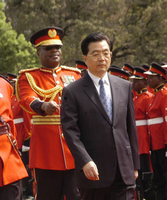China's rapid rise as a global economic power was brought into sharp relief during the March 2009 G-20 finance ministers meeting when, for the first time, pundits speaking about the event used the label "G-2" to signal that the world -- economically speaking -- now had two contending powers: China and the United States.
China's rise has, in turn, sparked enormous interest in its development model and the contrast that presents to much of the "Washington Consensus" on development policy. At the same time, the Chinese have sharply increased their foreign assistance, most visibly in Sub-Saharan Africa, after a lull of several decades. China's development aid reflects, in part, its understanding and assumptions about the road out of poverty. In this and other ways, it presents a challenge to the international aid architecture.
This challenge includes a number of elements that extend beyond the contrasting development models. On the one hand, many believe that China's aid, export credits, and non-concessional development loans will spark a "race to the bottom," by offering financing at competitive rates but without requiring environmental and social protections, or governance and economic conditions. Others argue that the large loans China is believed to be making to several developing countries will spark a new debt crisis.

